ASUS UL80Vt and G51J: Going for the Gold
by Jarred Walton on December 15, 2009 1:30 AM EST- Posted in
- Laptops
ASUS G51J Gaming Performance
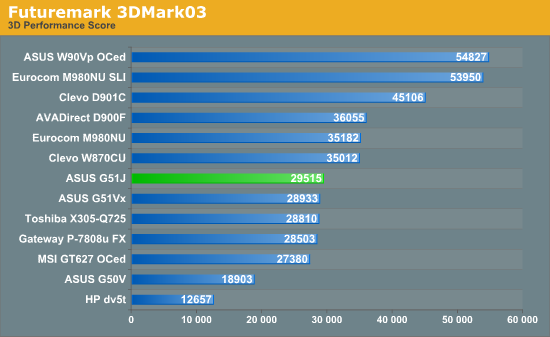
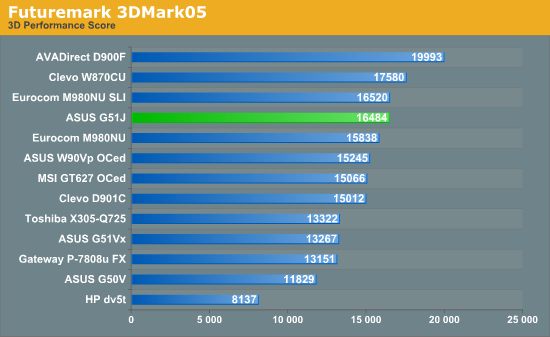
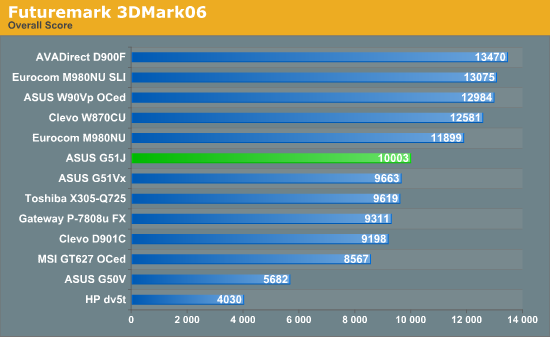
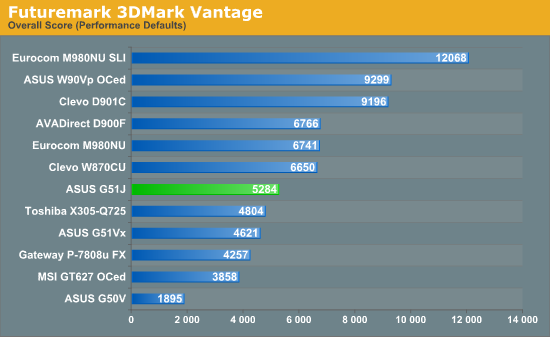
3DMark shows more of a theoretical potential for the various GPUs, before CPU performance becomes a potential bottleneck. Granted, most of these laptops have CPUs that are plenty fast, but just as no two games show identical requirements, 3DMark is at best one additional test to run rather than a replacement for gaming benchmarks.
We do have G51Vx results, which are missing in the gaming tests, and two of the 3DMark versions (03 and 06) show less than a 5% difference between the G51J and G51Vx. 3DMark05 and Vantage on the other hand show the G51J leading the G51Vx-A1 by 24% and 14%, respectively. In our limited gaming tests on the G51Vx, we didn't encounter any performance issues that were different from what we see on the G51J; at 1680x1050 or 1920x1080, the GTX 260M GPU is the major bottleneck on either system.
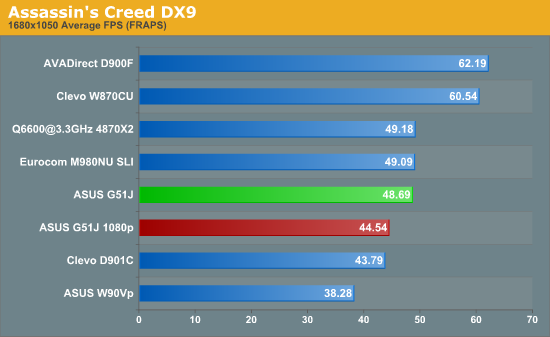

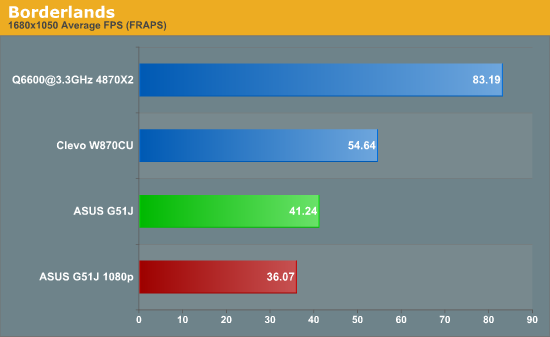
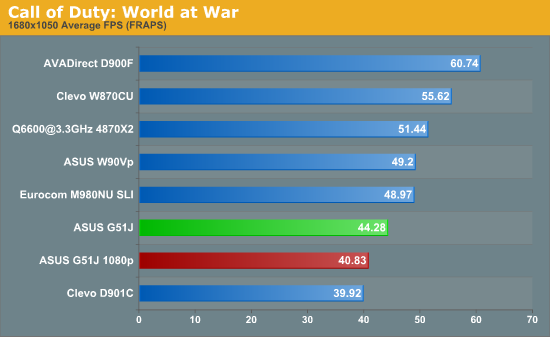
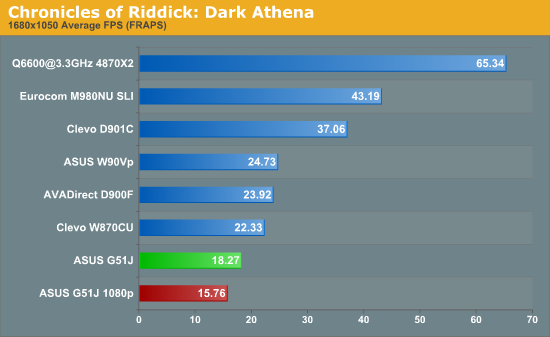
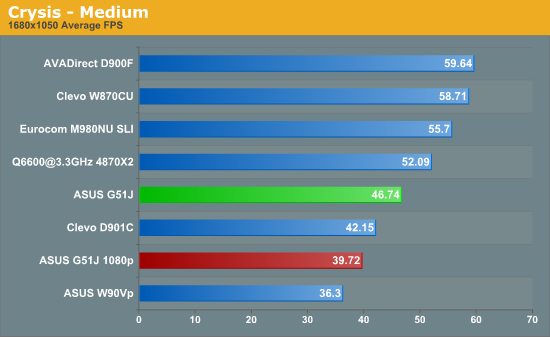



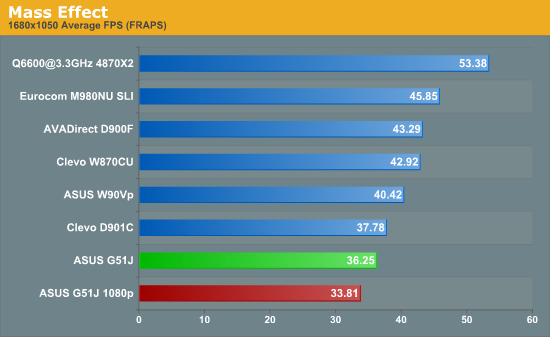
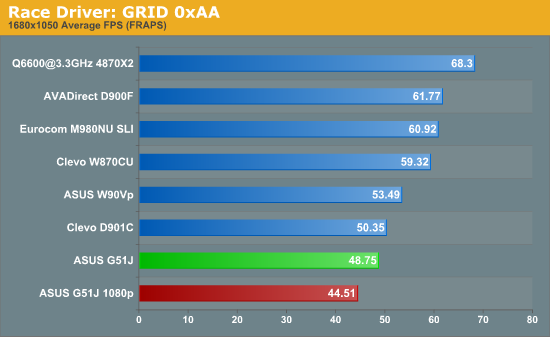
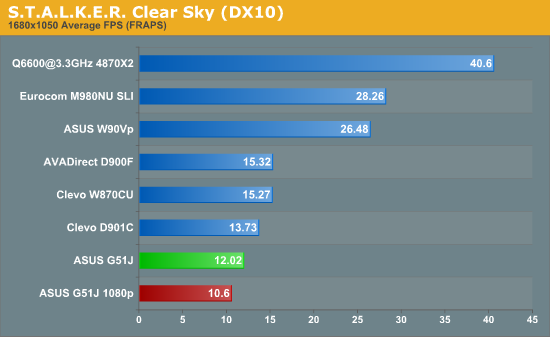
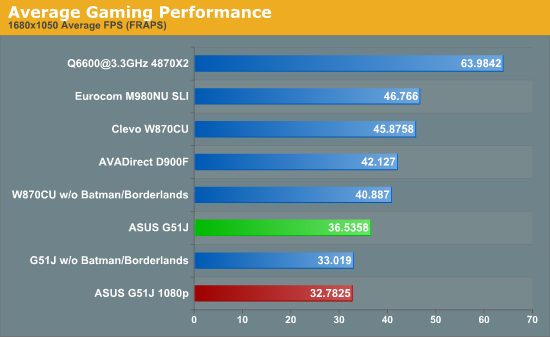
Gaming performance shows just how well the G51J does for the price. The W870CU is about 25% faster, but it's pretty much all from the GPU in these tests. That's about in line with the minimum price difference to upgrade to a notebook with GTX 280M (currently those start at around $1800). In the vast majority of games, either you can run at max detail settings without trouble or you'll need to turn down some settings on both the GTX 260M and the GTX 280M. If that's not acceptable, you could look at SLI GTX 280M solutions, but they're a big step up in price and we're still stuck with Core 2 models in that case.
Outside of antialiasing, we maxed out the settings for all of the games we test. Dark Athena, Crysis, Empire: Total War and STALKER: Clear Sky are too demanding for mobile GPUs at those settings, but Medium to High detail will work fine, even at 1080p. If you're one of those people that feel a need to max out every game setting, perhaps gaming laptops aren't the best idea. For most, the difference between High and Max is going to be relatively small in practice, and there are many titles (i.e. not Crysis) where even maximum detail will work well.










66 Comments
View All Comments
bennyg - Wednesday, December 16, 2009 - link
I think you're not getting the whole pictureRun it for an hour and then see the max temps then
When mine arrives I intend to downclock below the 9800MGTX speeds ... for longievity.
clarkn0va - Tuesday, December 15, 2009 - link
You may want to blur that picture of the bottom of the second laptop.JarredWalton - Tuesday, December 15, 2009 - link
Ummm... oops! Thanks.Zero110 - Wednesday, December 16, 2009 - link
YOU'RE TOO LATE!!! Just kidding.KikassAssassin - Tuesday, December 15, 2009 - link
I'm one of those people who has complained on the internet about the viewing angles, and I think your assessment is spot-on, because I came from an older laptop that had a higher-quality, but much dimmer, display. I do like that the UL80Vt's display is so much brighter than my previous laptop's, but the fact that such low-quality displays are commonplace nowadays is really sad. Companies will do anything to cut costs, I guess, but it's unfortunate that it's being done with such an important component. I guess most consumers don't care that much about the display quality, though, or else they wouldn't be able to get away with it. It would be nice if laptop manufacturers would at least offer the option of upgrading to a high-quality display. I would seriously have been willing to spend $1000 on a UL80Vt with a display on par with, say, the Macbook Pro or Dell Studio XPS (throw in a matte finish, an all-aluminum chassis, and a backlit keyboard, and you'd have the perfect laptop).Also, I notice in this article you said the graphics switch time takes about five seconds. I guess your fifteen second time to switch to the nvidia GPU went away when you reinstalled the old drivers? I'm still curious what might've been causing that.
JarredWalton - Tuesday, December 15, 2009 - link
I think it may have been either drivers or something else; at one point I broke the GPUs with updated Intel and NVIDIA reference drivers. (They altered the support list to explicitly exclude hybrid GPUs after that, I guess.) Anyway, it's working fine now. If you're running a 3D app when you try to switch, it will blank for a bit and then you'll get an exclamation point on the NVIDIA icon, which is maybe what happened before... worst I've seen that I can confirm worked was around 10 seconds.Agree on the LCD, finish, etc. I've got a Photodon cover for a 17" laptop that I'm going to test out in a little bit and see how that compares to running a native matte LCD.
zorxd - Tuesday, December 15, 2009 - link
What's the point of having a dedicated GPU in this laptop? It's too slow for gaming anyways. It's a thin and light laptop. Better to save 150-200$ to get a desktop computer to play games. The X4500MHD IGP will play 1080p movies just fine anyways. What else do you need? It's like people who want a dedicated GPU on an atom laptop or on their mac. Most of them will never make use of it.DominionSeraph - Wednesday, December 16, 2009 - link
WTH? It's the discrete graphics that make the UL80Vt interesting. Without it, there's no reason for it to have anything more than an Atom.Too slow for gaming? Jarred mentions playing Batman and Fallout 3 for several hours each. Sounds to me as though he was deriving entertainment value. Bet it plays WoW just fine, too.
With laptops, there's always tradeoffs between price, performance, portability, and battery life. The UL80Vt seems to hit a sweet spot.
And, honestly, for non-portable gaming, save yourself $600 and get a console.
zorxd - Tuesday, December 15, 2009 - link
the UL30A is much more interestingJarredWalton - Tuesday, December 15, 2009 - link
Someone asked me to run DXVA Checker on the G210M to see what it says. Here are the results for the interested:NVIDIA GeForce G210M
ModeMPEG2_IDCT: DXVA2, NV12, 720x480 / 1280x720 / 1920x1080
ModeMPEG2_VLD: DXVA2, NV12, 720x480 / 1280x720 / 1920x1080
ModeMPEG2_A: DXVA1, NV12, 720x480 / 1280x720 / 1920x1080
ModeMPEG2_C: DXVA1, NV12, 720x480 / 1280x720 / 1920x1080
ModeVC1_VLD: DXVA2, NV12, 720x480 / 1280x720 / 1920x1080
ModeVC1_IDCT: DXVA1/2, NV12, 720x480 / 1280x720 / 1920x1080
ModeWMV9_IDCT: DXVA1/2, NV12, 720x480 / 1280x720 / 1920x1080
ModeH264_VLD_FGT: DXVA2, NV12, 720x480 / 1280x720 / 1920x1080
ModeH264_VLD_NoFGT: DXVA2, NV12, 720x480 / 1280x720 / 1920x1080
9947EC6F-689B-11DC-A320-0019DBBC4184: DXVA2, NV12, 720x480 / 1280x720 / 1920x1080
B194EB52-19A0-41F0-B754-CC244AC1CB20: DXVA2, X8R8G8B8, 720x480 / 1280x720 / 1920x1080
For the record, DXVA Checker fails to get any useful information when using the GMA 4500MHD.